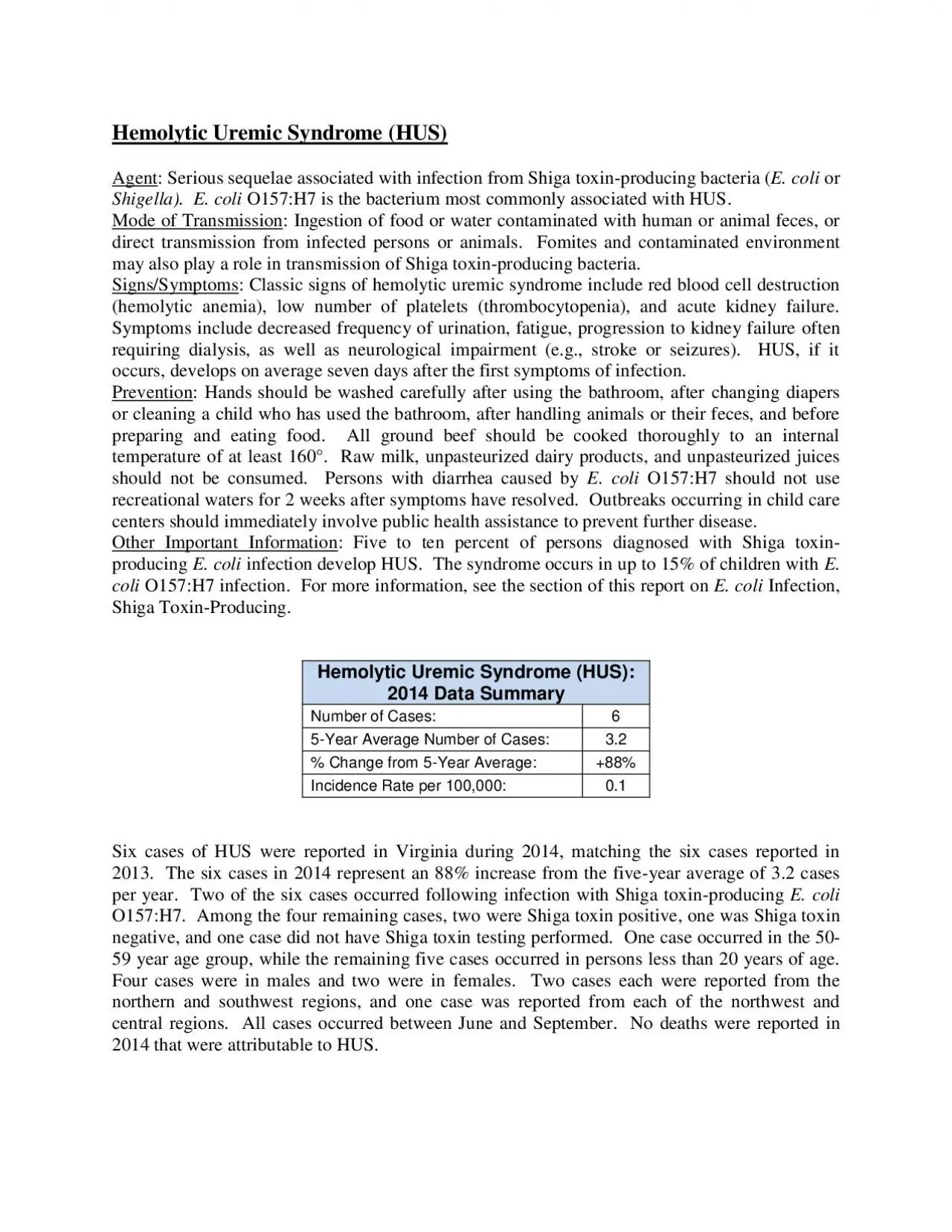

Agent Serious sequelae associated with infection from Shiga toxin producing bacteria E coli or Shigella E coli O157H7 is the bacterium mo st commonly associated with HUS Mode of Tra ID: 960780
Download Pdf The PPT/PDF document "Hemolytic Uremic Syndrome HUS" is the property of its rightful owner. Permission is granted to download and print the materials on this web site for personal, non-commercial use only, and to display it on your personal computer provided you do not modify the materials and that you retain all copyright notices contained in the materials. By downloading content from our website, you accept the terms of this agreement.
Hemolytic Uremic Syndrome (HUS) Agent : Serious sequelae associated with infection from Shiga toxin - producing bacteria ( E. coli or Shigella). E. coli O157:H7 is the bacterium mo st commonly associated with HUS . Mode of Transmission : Ingestion of food or water contaminated with human or animal feces, or direct transmission from infected persons or animals. Fomites and contaminated environment may also play a role in transmission of Shiga toxin - producing bacteria . Signs/Symptoms : Cla ssic signs of hemolytic uremic syndrome include red blood cell destruction (hemolytic anemia), low number of platelets (thrombocytopenia), and acute kidney failure. Symptoms include decreased frequency of urination, fatigue, progression to kidney failure often requiring dialysis, as well as neurological impairment (e.g., stroke or seizures). HUS, if it occurs, develops on average seven days after the first symptoms of infection. Prevention : Hands should be washed carefully after using the bathroom, after changing diapers or cleaning a child who has used the bathroom, after handling animals or their feces, and before preparing and eating food. All ground beef should be cooked thoroughly to an internal temperature of at least 160°. Raw milk, unpasteurized dairy products, and unpasteurized juices should not be consumed. Persons with diarrhea caused by E. coli O157:H7 should not use recreational waters for 2 weeks after symptoms have resolved. Outbreaks occurring in child care centers should immediately inv olve public health assistance to prevent further disease. Other Important Information : Five to ten percent of persons diagnosed with Shiga toxin - producing E. coli infection develop HUS. The syndrome occurs in up to 15% of children with E. coli O157:H7 inf ection. For more information, see the section of this report on E. coli Infection, Shiga Toxin - Producing. Hemolytic Uremic Syndrome (HUS) : 201 4 Data Summary Number of Cases: 6 5 - Year Average Number of Cases: 3.2 % Change from 5 - Year Average: + 88 % Incidence Rate per 100,000: 0.1 S ix cases of HUS were reported in Virginia during 201 4 , matching the six cases reported in 2013. The six cases in 2014 represent a n 88 % increase from the five - year average of 3.2 cases per year. T wo of the six cases occurred following infection with Shiga toxin - producing E. coli O157:H7 . Among t he four remaining cases , two were Shiga toxin positive , one was Shiga toxin negative , and one case did not have Shiga toxin testing performed . One case occurred in the 50 - 59 year age group , while the remaining five cases occurred in persons less than 20 years of age. Four cases were in male s and two were in fe male s . T wo cases each were reported from the northern and southwest region s , and one case was reported from each of the nor thwest and central region s . All c ases occurred between June and September . No death s were reported in 2014 that were attributable to HUS .